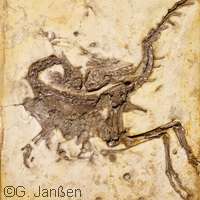Study finds decomposition responsible for fossilised deformations

A two-man research team from Germany and Switzerland has discovered how the decomposition of dead dinosaurs triggered strange deformations of fossilised dinosaurs. The finding counters what most researchers believed, i.e. that the dinosaurs' twisted posture was the result of death spasms.
The near-complete and articulated skeletons of dinosaurs with a long neck and tail usually exhibit a body posture in which the head and neck are recurved over the back of the animal. This posture, also known from Archaeopteryx, has been fascinating paleontologists for over 150 years. It was called `bicycle pose¿ when talking with a wink, or 'opisthotonic posture' in a more oppressive way of speaking. Opisthotonic posture is triggered by a lack of vitamins, poisoning or damage to the cerebellum.
The cerebellum is a region in the brain that controls fine muscle movement. Antigravity muscles, responsible for ensuring the head and tail are kept upright, are found in the cerebellum. Operational failure of the cerebellum leads to the full clenching of antigravity muscles, and then the tipping of the head and tail and limb contraction.
Approximately 100 years ago, scientists considered such a syndrome affecting various vertebrate fossils to be a petrified expression of death throes. Despite this view garnering some support in the early days, researchers opposed the interpretation as the years passed.
The 'opisthotonus' theory re-emerged in 2007. In this latest study, the German and Swiss researchers re-investigated this theory by examining the famous bipedal dinosaur Compsognathus longipes from Solnhofen Archipelago in Germany. Experts in the field concur that this dinosaur was embedded in a
watery grave of a tropical lagoon.
"In our opinion, the most critical point in the newly discussed scenario of the preservation of an opisthotonic posture in a fossil is the requirement that terrestrial vertebrates must have been embedded immediately after death without substantial transport," explains Achim Reisdorf, a sedimentologist from the Institute of Geology and Palaeontology at the University of Basel in Switzerland. "But consigning a carcass from land to sea and the following need of sinking through the water column for only a few decimetres or meters is nothing else."
The duo believed that post-mortem alterations of a decaying carcass led to the arching of the back. With this in mind, the researchers used plucked chicken necks and thoraxes immersed in water to test their theory.
These necks arched backwards at more than 90 degrees while in the water. The degree of the pose intensified as the decay progressed over months. They found a special ligament connecting the vertebrae at their upper side were responsible for the chickens' recurved necks. This ligament, what experts call 'ligamentum elasticum', is prestressed in both living and dead chickens.
"Veterinarians may often have to do with sick and dying animals, where they see the opisthotonic posture in many cases," says Michael Wuttke, a palaeontologist from the Generaldirektion Kulturelles Erbe Rheinland-Pfalz in Germany. "Vertebrate palaeontologists, however, who want to infer the environment in which the animals perished and finally were embedded, have to elucidate post-mortem processes and biomechanical constraints too."
Says the team: "A strong Ligamentum elasticum was essential for all long-necked dinosaurs with a long tail. The preloaded ligament helped them [in] saving energy in their terrestrial mode of life. Following their death, at which they were immersed in water, the stored energy along the vertebra was strong enough to arch back the spine, increasingly so as more and more muscles and other soft parts were decaying. It is a special highlight that, in the Compsognathus specimen, these gradual steps of recurvature can be substantiated, too. Therefore, biomechanics is [behind] the post-mortem weird posture of a carcass in a watery grave, not death throes."
More information: Reisdorf, A.G. & Wuttke, M., article in Palaeobiodiversity and Palaeoenvironments, 2012. doi:10.1007/s12549-011-0068-y
Provided by CORDIS




















